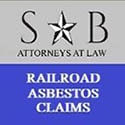
What Is Mesothelioma?
Mesothelioma is a rare cancer that starts in the mesothelium, a layer of tissue that lines the outside of the lungs, called the pleura, and the inside of the chest wall and abdominal cavity.
While many tumors have clear, defined edges, mesothelioma does not. Instead, it can surround organs and fill in the chest and abdominal cavity, compressing the lungs.
Mesothelioma causes
Mesothelioma usually is caused by past exposure to asbestos. Asbestos is a fibrous mineral that in the past was used in several industries. These include construction, automotive, military, marine and manufacturing.
When tiny particles of asbestos are made or disturbed, they can float in the air. People then can breathe in or swallow the asbestos.
Asbestos fibers can remain in the body for decades. In some cases, these fibers cause genetic changes to mesothelial cells, leading to mesothelioma. The disease typically occurs 30 to 50 years after a person has come in contact with asbestos. Often patients will not be aware of this past asbestos exposure.
Asbestos can cause serious health conditions other than mesothelioma. These include cancers of the lung, larynx and kidney. It also can cause asbestosis, a non-cancerous, chronic lung disease.
Types of mesothelioma
Most cases of mesothelioma start in the pleura. This type of mesothelioma also is called malignant pleural mesothelioma.
A rarer type of mesothelioma starts in the abdomen and is called malignant peritoneal mesothelioma.
Mesothelioma is also categorized by the type of mesothelial cells where the disease starts. These types of mesothelioma are:
- Epithelioid: This accounts for 60% to 70% of mesothelioma cases. It usually has the best outcomes.
- Sarcomatoid: About 10% to 15% of cases are sarcomatoid mesothelioma. It is more aggressive than epithelioid mesothelioma.
- Biphasic or mixed: This type of mesothelioma has both epitheliod and sarcomatoid cells. Between 10% and 15% of cases fall into this category. This is an extremely aggressive form of the disease.
Railroad Workers Exposed To Asbestos
For more than half a century, asbestos was a heavily used material that had several different applications including the production of:
- Asbestos insulation
- Asbestos cement
- Brake pads
- Brake linings
- Ceiling tiles
- Clutches
- Electrical panels
- Floor tiles
- Gaskets
- Pipe covering
- Plaster
- Rail ties
- Sealing cement
- Steam engines
- Wallboard
The individuals who worked in close proximity to these asbestos materials were at high risk for developing health conditions, including mesothelioma, from exposure to this toxic mineral. While the usage of asbestos came to a halt in the 1980s, older equipment and products still created risks for those working around them. The more stress and strain these older products face, the more likely it is for asbestos particles to become inhaled or ingested. Whether you have been diagnosed with mesothelioma or not, our attorneys want to hear from you if you were employed by a railroad company prior to 1982.
Mesothelioma Diagnosis in Railroad Worked
Railroad workers exposed to asbestos are at significantly higher risk for developing mesothelioma than the general population. This is due to the high volume of asbestos containing products and their close handling. Railroad workers that worked with steam locomotives are at the highest risk for developing an asbestos related disease and most likely to have been exposed to asbestos dust. It is believed that more than 1/5th of railroad employees over the age of 50 experienced significant exposure to this toxic material. Out of those who have been exposed to asbestos, it is estimated that somewhere between 2-10% of individuals develop mesothelioma.
Symptoms of Mesothelioma
Signs and symptoms of this illness include the following:
Pleural mesothelioma, which develops in the tissue that surrounds the lungs, causes signs and symptoms that may include:
- Chest pain
- Painful coughing
- Shortness of breath
- Unusual lumps of tissue under the skin on your chest
- Unexplained weight loss
Peritoneal mesothelioma, which is found in tissue in the abdomen, causes signs and symptoms that may include:
- Abdominal pain
- Abdominal swelling
- Nausea
- Unexplained weight loss
Free Consultation For Railroad Workers Exposed to Asbestos
At Sammons & Berry, P.C. we offer a no-cost, no-obligation consultation, so you can discuss the facts of your case without paying for anything upfront. Asbestos trusts claims do not require a lawsuit, depositions, or courtrooms. The process is simple and easy for the client and should not require any stressful legal confrontations for the client. The law firm handles all of the claims for the client, helping you maximize your compensation. We do not accept any payments from our clients until they receive compensation. We charge on a contingent fee basis, which means you pay a percentage of what you get paid in your claim. If we are unable to collect anything for you, there is no cost to you.
Call (800) 519-1440 to speak with a Sammons and Berry, P.C. representative and start your journey towards compensation.
Wrongful Death Claims For Families of Asbestos Victims
If you have lost someone in your family due to the harmful exposure of asbestos, you may be entitled to compensation. If you can provide the work history and a death certificate for your loved one, our attorneys can help you file an asbestos claim. We understand how difficult this process can be, this is why we work with you every step of the way to help you get the money you deserve. Reach out to our team today to learn more about filing a claim for a family member.
See if you qualify for compensation
Sammons & Berry, P.C.
800-519-1440
Google Listing
Facebook


